A History of the County of Buckingham: Volume 4. Originally published by Victoria County History, London, 1927.
This free content was digitised by double rekeying. All rights reserved.
'Parishes : Leckhampstead', in A History of the County of Buckingham: Volume 4, ed. William Page( London, 1927), British History Online https://prod.british-history.ac.uk/vch/bucks/vol4/pp180-187 [accessed 26 January 2025].
'Parishes : Leckhampstead', in A History of the County of Buckingham: Volume 4. Edited by William Page( London, 1927), British History Online, accessed January 26, 2025, https://prod.british-history.ac.uk/vch/bucks/vol4/pp180-187.
"Parishes : Leckhampstead". A History of the County of Buckingham: Volume 4. Ed. William Page(London, 1927), , British History Online. Web. 26 January 2025. https://prod.british-history.ac.uk/vch/bucks/vol4/pp180-187.
In this section
LECKHAMPSTEAD
Lechamstede (xi cent.).
The parish of Leckhampstead, on the borders of Northamptonshire, has an area of 2,570 acres, of which 348 are arable land, 1,796 permanent grass and 179 woods and plantations. (fn. 1) The soil is clay and gravel; the subsoil various. The undulating surface, about 300 ft. above ordnance datum, rises to 350 ft. in the east and north. The Ouse, which here flows in an easterly direction, forms the southern boundary. The Grand Junction Canal intersects the south of the parish, and is crossed at Cattleford Bridge by the road from Buckingham to Stony Stratford. Leckhampstead Wharf is about a quarter of a mile west of the bridge.
The village lies near the centre of the parish on a road branching north-west from the Buckingham road. It is divided into Church End at the north, where are the church of St. Mary and the schools, Middle End and South End, and is watered by a stream called the Leck, which rises in Whittlebury Forest, and is spanned here by South End Bridge. About a quarter of a mile east of Church End is Limes End with Limes End Bridge, formerly the manor of Little Leckhampstead, Great Leckhampstead occupying the north of the parish, and the space between being called Tween Towns. (fn. 2)
A large manor-house, the seat of the lords of Great Leckhampstead, described by Browne Willis as 'moated about antiently,' formerly stood west of the church, adjoining the churchyard; but according to this authority it was 'good part of it pulled down' by Lady Wentworth in the first half of the 18th century, and 'made a Tenants' house.' (fn. 3) The present house, a plain stone building of the 17th century, is occupied as a farm-house by Mr. Henry George Hurst. 'A newly built house in Nast End,' referred to among the possessions of Sir Edward Tyrell of Little Leckhampstead at his death in 1606, (fn. 4) was probably the Toy, built in 1603 at a cost of £3,000. Browne Willis describes it as 'a lofty house of good freestone,' but in a bad state of repair, and converted into a farm-house long before 1735. (fn. 5) Toye Court or Lower Farm is a modern house about half a mile south-east of the church, but it has two early 17thcentury windows, which probably came from the Toy above referred to.
Home Farm at South End is a 17th-century house, and retains its original staircase with twisted balusters and moulded handrail. A wing at the back is dated 1762, and built into the east wall are two stone windows with moulded jambs and mullions, said to have been brought from a house which stood near the farm.
The Rectory, about a quarter of a mile north-east of the church, is a handsome house, pleasantly situated on a hill, and surrounded by shrubbery and meadow.
The extreme north of the parish is occupied by Leckhampstead Wood, with Notamore Copse, Libby Wood and part of Wicken Wood. South of these woods are Hill Farm Wood House, Brook House and Lodge Farm.
Among place-names have been found Nutthrop End (fn. 6) (xvii cent.), Fishwater Meadow and the Harriotts (fn. 7) (xviii cent.).
Manors
At the date of the Domesday Survey 18 hides in LECKHAMPSTEAD were included among the lands of the Bishop of Bayeux. (fn. 8) This manor Earl Lewin had previously held, (fn. 9) and after the confiscation of the bishop's fief this holding, like those of his other chief tenants, (fn. 10) became a barony, called the barony of Maminot (Mamisnot), (fn. 11) after the Domesday tenant Maminot, (fn. 12) held of the Crown in chief, and owing ward to Dover Castle. (fn. 13) Maminot was probably soon displaced by Geoffrey de Mandeville, lord of another manor in Leckhampstead at the Survey, since this 18-hide manor was held for one fee of Geoffrey's heirs, the Says, (fn. 14) in the 13th (fn. 15) and 14th centuries, (fn. 16) Geoffrey de Say renouncing any claim in the advowson, doubtless as overlord, before 1219. (fn. 17) At the death of Elizabeth Baroness Say in 1399, and the partition of her property among her co-heirs, the three sisters of her father William de Say, the overlordship of this fee appears to have passed to Mary and Maud, the daughters and co-heirs of the second sister Elizabeth and of her husband Thomas de Aldon. (fn. 18) Sir William Heron, the second husband of Elizabeth Baroness Say, who held the overlordship rights here with her in 1396, (fn. 19) styled himself Lord Say, and possessed himself of many of his wife's estates after her death in 1399. In the following year he obtained a release of all her right in this fee from Thomas de Aldon's daughter Maud, wife of Thomas Bosenho, (fn. 20) and died seised of it in 1404. (fn. 21) A century later his interest appears to have come into the possession of the descendants of William de Say's third sister and co-heir Joan, wife of Sir William Fiennes, as the overlordship was stated in 1511 to be vested in John Fiennes, Lord Saye, (fn. 22) and in 1520 in Edward Fiennes, son and heir of Thomas Fiennes, Lord Clinton and Saye. (fn. 23)
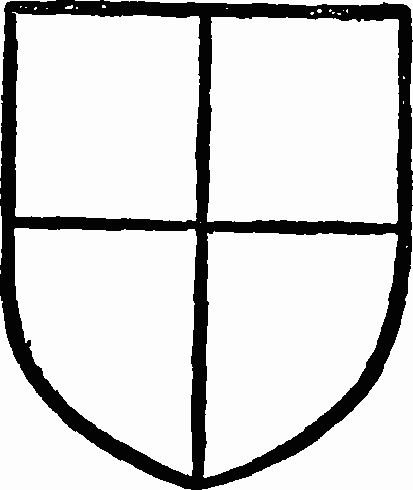
Say. Quarterly or and sable.
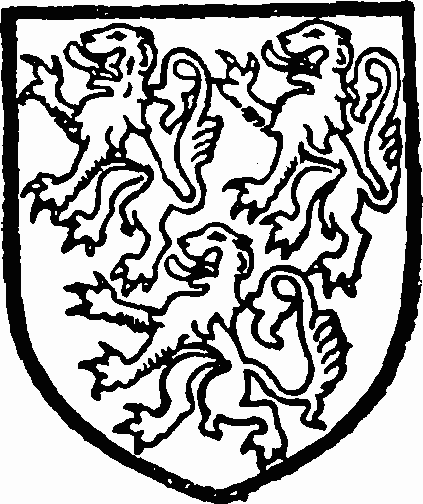
Fiennes. Azure three lions or.
By the end of the 12th century the manor had been subinfeudated to Hugh Chastillon, who in 1199 levied a fine of lands here with Richard Chastillon, (fn. 24) probably identical with his son and heir Richard, whose widow Parnel, daughter of Ralph Pirot, received in 1205 from her father-in-law Hugh Chastillon a third of the vill in dower, with the advowson of the church. (fn. 25) Hugh seems to have been succeeded by his son Hugh, to whom Parnel Pirot and Hugh son of Richard, apparently her son, released the advowson before 1219, (fn. 26) and who as Hugh son of Hugh granted land in Leckhampstead in 1219 to Richard Chastillon. (fn. 27) Hugh Chastillon obtained a verdict from the bishop in 1223 that he was lawfully married to Gunnora de Bray, (fn. 28) and was dealing with land in Leckhampstead in 1228 and 1229. (fn. 29) Sir Hugh Chastillon presented to the church in 1251, (fn. 30) and was returned as lord of Leckhampstead in 1254. (fn. 31) He was alive in 1260–1, (fn. 32) but had been succeeded by his son Richard Chastillon before 1279, in which year Richard died seised of the manor, which then passed to his son Hugh. (fn. 33) Hugh Chastillon held Leckhampstead during the reigns of Edward I and Edward II, (fn. 34) and was knight of the shire for 1300 and 1301. (fn. 35) Between 1316 and 1323 he was succeeded by Richard Chastillon, (fn. 36) his son, (fn. 37) who was sued for debt in 1327 (fn. 38) and 1330. (fn. 39) He, who was knight of the shire in 1331 and again ten years later, (fn. 40) in 1332 settled two-thirds of the manor and the reversion of the third held by Hawise widow of Hugh in dower on himself for life, with remainder to his son Hugh and the latter's wife Margaret. (fn. 41) In 1344 he settled messuages, land and rent in Great Leckhampstead and Foscott on himself and his wife Elizabeth, with remainder to their son Richard and his heirs male, (fn. 42) and was still holding the manor in 1346. (fn. 43) He was succeeded probably before 1356 by his son Hugh, who was Sheriff of Bedfordshire and Buckinghamshire in that year, (fn. 44) and presented to the church in 1359. (fn. 45) In 1366 a commission of array was issued to this Hugh, (fn. 46) and he was still alive in 1379. (fn. 47) His son Richard had a daughter and heir Elizabeth, who with her husband William Gernon was plaintiff in an action concerning Clanfield Manor, Oxfordshire, in 1396. (fn. 48) In 1434 William and Elizabeth Gernon settled Leckhampstead on themselves and issue, (fn. 49) but were obliged to sue the trustees for refusing to reenfeoff them. (fn. 50) Their son and heir Thomas was succeeded by a son William, who put in a claim to Thornton Manor (q.v.) in 1464, (fn. 51) and died in 1479, leaving a son William, aged fourteen. (fn. 52) The Gernon line ended in an heir Joan, who brought the manor to her husband Ralph Tylney, citizen and alderman of London, with whom in 1488 she inspected the settlement of 1434, Elizabeth Hill, widow, being also a party to the proceedings. (fn. 53) Ralph's son Reginald Tylney died in 1506, (fn. 54) before his mother Joan, who by her will, dated and proved in 1509, left a legacy to his daughter and heir Elizabeth. (fn. 55) Elizabeth died in January 1510–11, her heir being her father's brother John Tylney. (fn. 56) He, who was twice married—his first wife's name being Lucy and that of his second Margaret—died on 15 May 1518. His will, made four days earlier, appointed his wife Margaret his executrix, and settled the manor on her and his heirs by her. (fn. 57) Margaret later instituted proceedings against John Mylborne, citizen and alderman of London, and other feoffees, who refused to make an estate to her, (fn. 58) and died in London on 15 January 1518–19, a week after the birth of a daughter and heir Joan. (fn. 59) Joan married Richard Greenway of Dinton, lord of Woodrow Manor in Amersham (q.v.), with which Leckhampstead descended until the end of the century. Joan's second husband, Michael Harcourt, was ordered in 1587 to appear before the council on the complaint of Marmaduke Claver (of Foscott Manor), (fn. 60) who had instituted proceedings against him as to right of intercommon between the two manors, (fn. 61) but with whom he finally promised to be 'good neighbours,' and not to unjustly molest nor vex him. (fn. 62) His daughter Winifred married his stepson Anthony Greenway, with whom and with their son Richard he was dealing with the manor in 1595. (fn. 63) He died in 1597, (fn. 64) and in the year following his death John Chowe of Leckhampstead instituted proceedings in Chanory, claiming that when Michael Harcourt had been sheriff (which was in the year 1594–5) (fn. 65) he as under sheriff had made payments and borrowed money on his account. (fn. 66) In 1599 Anthony Greenway, in conjunction with his mother Joan Harcourt and his wife Winifred, made a settlement of Leckhampstead after the death of his mother, wife and himself, on his son Richard and the latter's wife Elizabeth, in tail-male. (fn. 67) He died on 28 January 1618–19 and was succeeded by Richard, (fn. 68) who died in the following August, when the manor passed to Richard's son Anthony. (fn. 69) Anthony, then just under twenty-one, appears to have been in money difficulties within a few years of his father's death. He was dealing with the manor in 1624 in conjunction with Beale Sapperton, (fn. 70) with whom and with John Pollard he and his wife Amphillis conveyed messuages and lands in Leckhampstead to Edmund Pye in that year. (fn. 71) In 1626 proceedings were instituted against Anthony Greenway and Amphillis by Thomas Packington of Shoelands in Puttenham (co. Surrey), who claimed the chief messuage and lands as security for£600 paid to them by him to purchase an annuity from the manor. (fn. 72) In 1628 Anthony Greenway and Amphillis his wife, Thomas Packington and Anne his wife, and John Pollard and Katherine his wife conveyed the manor to Edmund Pye (of St. Martin's, Ludgate, London) and his son and heir Edmund. (fn. 73) The elder Edmund was still alive in 1635, (fn. 74) in which year the younger Edmund married Katherine, sister of John first Lord Lucas of Shenfield. (fn. 75) The son was made a baronet as Sir Edmund Pye of Leckhampstead in 1641, and knighted four days later. (fn. 76) In 1646 he compounded on the Articles of Oxford; he had lived at Oxford for three years, his fine, a tenth, being set at £3,865. (fn. 77) He died in 1673, and was survived by his wife Dame Katherine and his two daughters and co-heirs—Martha, who married John third Lord Lovelace, of Hurley, and Elizabeth wife of the Hon. Charles West. Sir Edmund Pye's widow died in 1701, and the manor passed to Elizabeth West, at whose death it descended to Martha Lovelace, only surviving child of Martha Pye and John Lord Lovelace, Baroness Wentworth in her own right. (fn. 78) She married Sir Henry Johnson, who died in 1719, and after nearly pulling down the old manor-house, she died childless in 1745. (fn. 79) Under her will the manor passed to Martha, sister of the last Lord Lovelace, who had married Lord Henry Beauclerk, fourth son of the first Duke of St. Albans. (fn. 80) She being then a widow, with her son and heir-apparent the Rev. Henry Beauclerk, then of Christ Church, Oxford, barred the entail on the manor on 17 November 1769. (fn. 81) At her death in 1788 she was succeeded in the manor by her son Henry, then incumbent. (fn. 82) He was holding the manor in 1793 with his son John Beauclerk, (fn. 83) and was lord in 1811. (fn. 84) He was succeeded by his son John Beauclerk, whose son Henry William Beauclerk succeeded in 1840, (fn. 85) and was lord until his death in 1894. (fn. 86) Before 1899 the manor had passed to its present owner, Mr. Lawrence James Baker of Brambridge Park, Eastleigh (Hants).
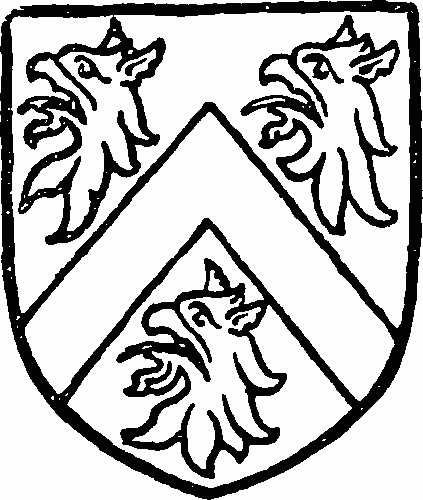
Tylney. Argent a cheveron between three griffons' heads gules having beaks or.
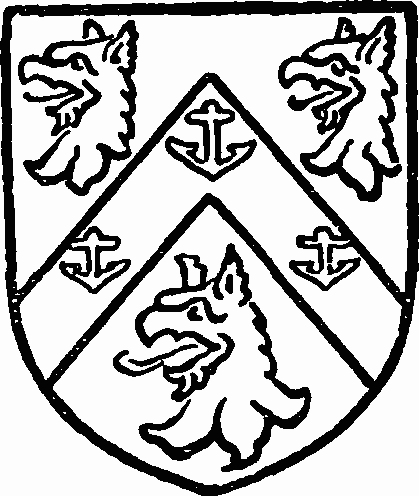
Greenway. Gules a cheveron between three griffons' heads razed argent with three anchors sable on the cheveron.
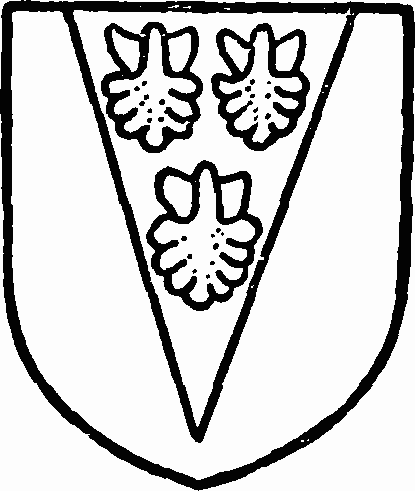
Pye of Leckhampstead, baronct. Or a pile azure with three scallops or thereon.
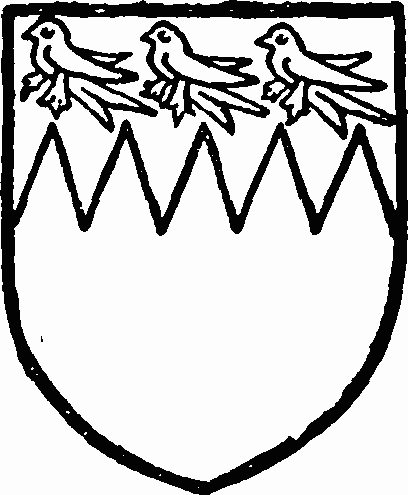
Lovelace. Gules a chief indented argent with three martlets sable therein.
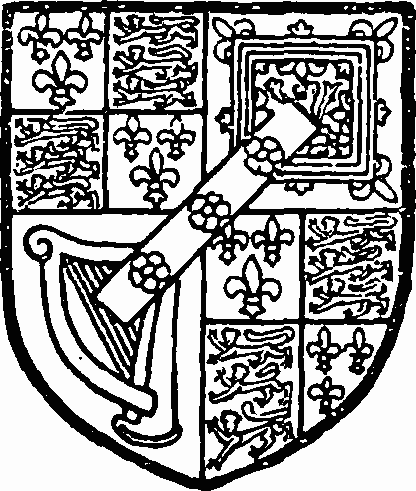
Beauclerk. The royal arms of King Charles II with the difference of a sinister baston gules cut off at the ends and charged with three silver roses.
Two hides included among the lands of Walter Giffard in 1086 and previously held by Suartin, a man of Asgar the Staller, (fn. 87) with 3 hides previously held by Suartin, and included among the lands of Geoffrey de Mandeville at that date, (fn. 88) were afterwards held for half a fee and two-thirds of a fee respectively, and though these 5 hides had amalgamated under the same tenant by 1225, when they were held for one and a sixth fee, (fn. 89) the distinction between the amount of service due from each portion was maintained during the 13th century. (fn. 90) The greater amount was wrongly assigned to the 2-hide holding in 1254, (fn. 91) but the mistake was rectified in 1279. (fn. 92) The total service due from the combined estate was given in 1284–6, (fn. 93) but after that date, with the disappearance of the Mandeville overlordship, the military service rendered by his part of Leckhampstead fell into abeyance, and the manor continued to be held for half a fee only until the abolition of feudal tenure in the 17th century. (fn. 94)
The 2 hides of Walter Giffard united with the rest of his lands to form the honour of Giffard, (fn. 95) which descended in the 13th century to the Marshals, Earls of Pembroke, (fn. 96) and later passed to their successors the Valences, Earls of Pembroke. (fn. 97) From them it was inherited by the Lords Talbot, (fn. 98) who claimed view of frankpledge here in 1371. (fn. 99) Their overlordship rights cannot be traced after 1419, (fn. 100) but the Earls of Oxford, who held an intermediary lordship under the Marshals in the early 13th century, (fn. 101) claimed services in this half fee until the middle of the 17th century. (fn. 102)
Yet another intermediary lordship under the Earls of Oxford was exercised by Roger de Missenden and his heirs during the 13th and 14th centuries. (fn. 103)
The 3 hides which pertained to Geoffrey de Mandeville in 1086 were later held of his descendants the Earls of Essex and Hereford, (fn. 104) but their connexion with Leckhampstead ceases some time after 1279, when an intermediary lordship was held under them by Roger de Missenden, who also occupied the same position with regard to the other fee at that date. (fn. 105) Missenden's interest may be represented by Richard Moore of Aylesbury, who in 1606 had overlordship rights in this manor worth 6d. yearly. (fn. 106)
The under-tenants of Walter Giffard and Geoffrey de Mandeville in 1086 were Hugh and Osbert respectively. (fn. 107)
Richard Fitz Osbert, who received a grant of 8 acres of assart in Leckhampstead in the forest of Whittlewood from Henry II, (fn. 108) probably held as successor to the Domesday Osbert, and may have been identical with the Richard Fitz. Osbert who was Sheriff of Bedfordshire and Buckinghamshire in 1159, 1160, 1165, 1166. (fn. 109) It was doubtless a descendant of the same name who in 1224–5 held both Domesday manors, (fn. 110) which he granted to Richard son of Richard, probably his son, to hold at a rent of 12d. for all service, saving the foreign service due. (fn. 111) Richard son of Richard was holding as late as 1254, (fn. 112) but before 1279 had been succeded by William son of Roger. (fn. 113) It was probably the same William who as William de Leaume was holding the manor in 1284, (fn. 114) and who in 1293 purchased certain rents in Leckhampstead from Gregory de Meldeburne and Isabel his wife. (fn. 115)
In 1302 this estate, first here called LECKHAMPSTEAD MANOR, and later known as LYMES END, had passed to Alan de Leaume, (fn. 116) who was still in possession in 1316. (fn. 117) It was probably a successor of the same name who in 1323–5 was before the justices for an assault on William Chastillon, parson of Bedhampton, Hampshire, of which he, his wife Cecilia, his son John, and Richard, 'Alan's priest of Lenne,' had been guilty at Little Leckhampstead. (fn. 118) Alan de Leaume and his sons seem to have carried on a feud with the Chastillon family, and in 1333 Alan, with his sons John and Thomas and others, had to appear for carrying away the goods of Sir Malcolm Chastillon at Leckhampstead, (fn. 119) John son of Alan complaining in 1345 that Richard Chastillon of Great Leckhampstead and Hugh, Richard, John and William, his sons, had maimed and imprisoned him at Little Leckhampstead, so that his life was despaired of, and had mowed and carried away his crops. (fn. 120) In 1345 200 marks were owed by John de Wolverton to this son John, and to his father, described as Alan de Leaume of Little Leckhampstead, the elder, (fn. 121) and returned in the following year as holding Little Leckhampstead in succession to Alan de Leaume. (fn. 122) John's career ended in outlawry in 1347 'for the death of Geoffrey Fraunkleyn and others by him at divers times feloniously slain.' (fn. 123) His father, therefore, in 1353 enfeoffed Alan, his younger son, of the manor, which should have passed to John after his own death, and the younger Alan occupied it from that date. (fn. 124) After the death of his father, two years later, (fn. 125) the manor was seized into the king's hands by reason of John's felony, and was delivered by the king in 1360 to Michael de Ravensdale, parson of Leckhampstead, and Robert de Hornby, (fn. 126) but was restored with all issues to Alan as Alan de Leaume the younger in 1362. (fn. 127) In July 1384 complaint was made by Alan de Leaume that Henry de Barton and Lettice his wife, Richard Senkler, Roger Doget and others, by night broke his close and houses at Little Leckhampstead, assaulted him, took away six horses, three mares, ten oxen, eight cows, three bullocks and twenty hogs, value £20, felled trees and carried them off, as well as other goods, charters and writings, and assaulted servants. (fn. 128) The manor remained in the possession of the Leaumes, and was in 1413 conveyed by William de Leaume for 100 marks to William Pirton, clerk, and others, (fn. 129) to whom in the same year and term it was quitclaimed for a like sum by Henry Fraunkleyn and Elizabeth his wife, with warranty against the heirs of Elizabeth. (fn. 130) This grant, made apparently to feoffees, seems to have been followed by a lease to William Lacy, who in 1423 released to William Pirton the manor of Little Leckhampstead, which he had held for life by grant from him with remainder to Thomas de Leaume. (fn. 131) It had passed from Thomas de Leaume, possibly to a female heir, in 1428, when it was held by William Russell and Margaret his wife, who then granted it for 300 marks to John Morton and Richard English, with warrant against the heirs of Margaret. (fn. 132) In 1493 it was the property of Mary Middleton, who conveyed it in Easter term of that year for £300 to Richard Empson, (fn. 133) to whom in the same year and term it was conveyed by John Maunsell and Margaret his wife. (fn. 134) Described as a messuage with meadows, cottages, and copses called Lymeswoods, &c., formerly belonging to Walter Maunsell, (fn. 135) it reverted to the Crown on the attainder of Sir Richard Empson in 1512, (fn. 136) and was granted in that year to William Tyler. (fn. 137) It was held by George Saunders in 1537, (fn. 138) and had passed by 1557 into the hands of Thomas Pigott of Loughton, by whom it was then conveyed as the manor of Little Leckhampstead or 'Lemesend' (after its former owners) to George Tyrell, (fn. 139) already holding a manor of Leckhampstead, probably Nast End, and lord of Thornton (q.v.), with which it continued to be held until late in the 19th century. (fn. 140) An arbitration in 1811 between the Rev. Henry Beauclerk and Sir Thomas Sheppard, bart., which decreed that the former as lord of Leckhampstead Manor was also lord of the manors of Lymes End and Nast End, parcel thereof, (fn. 141) cannot have affected the manorial rights of Sir Thomas Sheppard, since his representative, the Hon. Richard Cavendish of Thornton, was lord circa 1860. (fn. 142)
The property known in the 17th century as the manor of NAST END appears to have in part originated in the grant of lands made by Hugh Chastillon in 1280, after the death of his father Richard, to Rose widow of the same Richard. (fn. 143) This consisted of one messuage and one-third of the profits of a dovecot belonging to it, but not the garden and fish-stew. She was also to have a third of a wood, and lands in Morsladefield, Longeneham, Sladefield and Northfield, with one-third of Marham Moor. All this was to be held of Hugh for a penny a year and to revert to him after Rose's death. (fn. 144) The land, however, afterwards assessed at 2 virgates, remained in Rose's heirs, and continued to be held of the Chastillons of Great Leckhampstead during the 14th century. (fn. 145) This estate was augmented by 2½ virgates subinfeudated to the Chastillons by the lords of Little Leckhampstead before 1279, (fn. 146) and held of the Leaumes during the 14th century. (fn. 147) An intermediary lordship of half a virgate of this part was held in the late 13th and early 14th centuries by Ellis Tingewick, (fn. 148) Roger de Missenden standing between him and the lord of Lymes End in 1279. (fn. 149) Temporary overlordship rights appear to have been obtained during the 14th century by eight other persons, (fn. 150) one of whom, William le Vavasour, owned lands in Great Leckhampstead in 1325. (fn. 151)
Rose Chastillon, the holder in fee of this combined estate, immediately after her husband's death married John Tingewick, (fn. 152) who was returned as free tenant in Little Leckhampstead in 1279. (fn. 153) In 1285 he and Rose acquired additional lands here from Hugh son of Ralf le Clerk and Agnes his wife, (fn. 154) and also purchased an estate from Ralf son of William de Plumpton, which at John Tingewick's death in 1304 reverted to William his son and heir by Rose. (fn. 155) William also enjoyed the property which had been settled on Rose in 1280 by Hugh Chastillon, but at William's death in 1316, though John Tingewick, his brother, was his heir-at-law, the Chastillon lands went to Malcolm son of Rose by Richard Chastillon. (fn. 156) Malcolm Chastillon was lord of Thornton Manor (fn. 157) (q.v.), with which this Leckhampstead property henceforward descends. The name Nast End first appears in 1606, when Sir Edward Tyrell died seised of a newly-built house in Nast End in Great Leckhampstead, which he bequeathed to his wife Margaret. (fn. 158) The Tyrells seem to have held their Little Leckhampstead property as Lymes End Manor and their Great Leckhampstead property as Nast End Manor. (fn. 159) In the early 19th century Nast End appears to have been absorbed into Lymes End, and is not mentioned separately by name after the arbitration of 1811. (fn. 160)
A mill was held with the manor of Great Leckhampstead in 1205, (fn. 161) and in 1279 the freeholders of Great Leckhampstead included John the Miller, who held a water-mill at a rent of 20s. (fn. 162) A mill was held by Hugh under Walter Giffard at the date of the Domesday Survey, (fn. 163) and in 1279 the freeholders of Little Leckhampstead included Richard the Miller, who held a water-mill rented at 26s. 8d. yearly. (fn. 164) This water-mill was among the appurtenances of Lymes End Manor in 1360, (fn. 165) and was doubtless one of the three or four water corn-mills standing on the Tyrells' Thornton and Leckhampstead estates in the 17th and 18th centuries. (fn. 166)
A several fishery in Great and Little Leckhampstead was held with Lymes End Manor in 1557, (fn. 167) 1573, (fn. 168) and 1606. (fn. 169)
Church
The church of the ASSUMPTION OF THE VIRGIN consists of a chancel measuring internally 27 ft. by 15 ft., north vestry, nave 56 ft. 6 in. by 19 ft., north aisle 9 ft. wide, south porch, and west tower 11 ft. square; it is built of rubble and roofed with tiles and lead.
The church dates from the early years of the 12th century, and originally consisted of the eastern part of the present nave to within 16 ft. of the west end, and probably a small chancel; the nave seems to have been lengthened westward about 1180, when the north aisle was built, the tower was added in the late 13th century, and the chancel was rebuilt and widened about 1350, while the south porch was added late in the 15th century. The whole fabric has been restored at a modern period.
The axis of the chancel does not line with that of the nave, the widening having been effected towards the north only. In the east wall is a modern threelight traceried window and there are two windows in each of the side walls; that at the south-east, of two lights with flowing tracery, is of about 1350, and opposite to it on the north is a window of similar character, but its tracery has been entirely renewed. The north-west window is also original, and is of two trefoiled lights with tracery in the head composed practically of one large multifoiled opening; the south-west window, entirely modern except the head, which dates from about 1500, is of three trefoiled lights in a four-centred head. On the north is a narrow 14th-century doorway with an ogee head and a label with head-stops and foliated finial, and on the south are two plain round-headed sedilia, one of which is much wider than the other. The pointed chancel arch and the open timber roof of the chancel are modern.
The nave is lighted by two modern windows in the south wall, each of three pointed lights. The south doorway, which dates from about 1120, has a round head of one order with a large edge roll supported by jamb shafts with carved bird-like capitals and chamfered abaci. Both shafts are enriched with scale and cheveron ornament, that on the east, which terminates below the capital in a monstrous head, having the appearance of a serpent. The tympanum, which rests on a flat lintel with diaper ornament, has a sculptured representation of two dragons which appear to dispute the possession of a long-eared human figure standing between them, and on the infilling above is some mediaeval paint. On the nave wall inside is a large pointed stoup with a modern round bowl. Opening to the aisle on the north is a late 12th-century arcade of four pointed arches supported by square piers and responds with moulded abaci and double-chamfered plinths, the latter extensively repaired. The arches are single chamfered on the side towards the aisle, but on the nave side are recessed in two moulded orders with engrailed labels. There are large grotesque stops at the junctions of the labels over the piers, and carved heads or flower ornament at their apexes, two of the heads having their faces turned towards the altar. Traces of 13th-century painting remain on the piers, including cheveron ornaments and other designs, and two inscriptions, 'Hic sedet Isabella' on the central pier and 'Ave Maria' on the easternmost pier, the last four letters being almost obliterated. The late 13th-century pointed tower arch in the west wall is the full width of the tower, and is of three chamfered orders which die into the walls on both sides. At the north-east of the nave is a 15th-century doorway to the rood-loft, and built into the wall below its sill is a piece of 12th-century stonework with diaper ornament.
The north aisle is lighted by three windows in the north wall and one in the west wall, all modern, except perhaps the head of the latter, which is a single trefoiled light. The north doorway, a good example of late 12th-century works, has a round arch of two moulded orders; the inner order is enriched with cheveron and foliated ornament, and the jambs are moulded with keeled edge rolls, while the outer order has attached jamb shafts, both rolls and shafts having rudimentary foliated capitals and moulded abaci; the label has enrichment like that of the inner order of the arch and has head-stops at the springing and the apex. The south porch has an original four-centred entrance archway, which has been repaired, and a restored two-light window in each side wall. A stone over the entrance is inscribed 'W.C. 1688,' and circles have been scratched on the south wall. Standing near the porch is the base of the mediaeval churchyard cross.
The tower is of three stages with buttresses at the angles of the ground stage, and is surmounted by an embattled parapet with a moulded string-course and gargoyles. The west doorway, which dates from about 1280, though slightly restored, has a pointed arch of two richly moulded orders, the inner continuous down the jambs and the outer supported by attached shafts with moulded capitals and bases. Above is a restored round-headed light of about 1180, which has been reset in the wall; the arch is of two orders, the outer being supported by attached jamb shafts with foliated capitals and moulded bases. The second stage is lighted by loopholes, and the bell-chamber by four windows, each of two lancet lights in an unpierced pointed head, all probably dating from the late 13th century.
The font has an early 14th-century octagonal bowl, four sides of which have sculptured representations of the Crucifixion, the Virgin and Child below a crocketed canopy, St. Catherine, and a bishop; the other four sides are embellished with conventional foliage, the leaves on the south-east side being connected by a strap-like ornament which might be confounded with earlier work but for the typical 14th-century foliage with which it occurs and in the design of which it obviously forms a part. The stem and base are modern. On the floor at the east end of the north aisle is a brass figure of a man in a fur-lined cloak with the inscription 'Hic jacet Regenoldus Tylney gentylman filius secundus Radulfi Tylney civis et aldermani londinii et unicus heres istius manerii qui obiit tercio die maii anno dñi MCCCCCVI.' Below are small figures of his three daughters and above are the arms of Tylney impaling Gernon; there is also an early 16th-century brass figure of a lady in a gabled head-dress, which was recently recovered from a house near by, and is now affixed to the south wall. Under the westernmost arch of the arcade is a table tomb, probably commemorating Hugh Chastillon, who died between 1316 and 1323, with the recumbent effigy of a knight in armour wearing a bascinet, cyclas, and long sword, and a shield on the left arm. On the north wall of the chancel is a tablet to Sir Anthony Greenway, who died in 1619. There is a 17th-century carved chair in the chancel.
The tower contains a ring of five bells; the treble and second were added in 1897; the third, inscribed 'Gaude Virgo mat(e)r,' dates from the first half of the 16th century; the fourth is inscribed 'Chandler made me 1664,' and the tenor 'Chandler made me 1662'; there is also a mediaeval sanctus, now in a framework at the west of the north aisle, inscribed 'Crestit me firi fecit.'
The communion plate consists of a beautifully chased cup of 1569 inscribed 'Leckhamstead Parish,' a paten of 1829, and a flagon of 1833.
The registers before 1812 are as follows: (i) all entries 1558 to 1754; (ii) baptisms and burials 1756 to 1812, several leaves of this book, some containing earlier entries, have been cut out; (iii) marriages 1754 to 1823.
Advowson
The church is mentioned in 1209–19, when Hugh Chastillon held the advowson, (fn. 170) which remained vested in the lord of the manor of Great Leckhampstead (fn. 171) until circa 1860, when it was held by Henry William Beauclerk. From him it passed circa 1882 to Mr. S. Tompkins, who held it until 1899, (fn. 172) and has since been again held by the lord of the manor.
The church was valued at £16 in 1291 (fn. 173) and at £15 13s. 4d. in 1535. (fn. 174)
Charities
The charity for a schoolmaster, founded by will of John Smith, proved in the P.C.C. 28 August 1806, is endowed with a sum of £315 consols, the annual dividends of which, amounting to £7 17s. 4d., are applied in support of the school.
The charity of the Rev. Heneage Drummond, founded by deed 6 October 1879, now consists of £278 10s. 6d. 2½ per cent. annuities, arising from the sale in 1899 of premises formerly known as 'The Chequers.' By a scheme of the Charity Commissioners of 7 June 1895 the annual dividentds, amounting to £6 19s. 4d., are applicable for parochial purposes, such as providing gratuitous lodging for a curate or schoolmaster, or the maintenance of a museum.
The Major Charles Hall Memorial Charity, founded by deed 4 March 1895, is endowed with a sum of £1,737 4s. 9d. India 3½ per cent. stock, purchased with a sum of £2,000, producing £60 16s. yearly, applicable for the benefit of the poor. In 1912 the distribution was made in medicines, food, in the payment of doctor's bills and in subscriptions to hospitals. The sum of £36 8s. 4d. was also distributed in Christmas gifts to about forty recipients.
The several sums of stock are held by the official trustees.
